The Roman Mosaic from Lod, Israel

«In 1996 mosaics were accidentally uncovered during highway construction in the modern Israeli town of Lod, not far from Tel Aviv (see map). Lod is ancient Lydda, which was destroyed by the Romans in A.D. 66 during the Jewish War. Refounded by Hadrian as Diospolis, Lydda was awarded the rank of a Roman colony under Septimius Severus in A.D. 200.» It remained in Roman hands until becoming a Christian city and eventually succumbing to Arab conquerors in A.D. 636. The discovery of the mosaics immediately prompted a rescue excavation, undertaken by Miriam Avissar for the Israel Antiquities Authority, which revealed a series of mosaic floors that measured approximately fifty by twenty-seven feet. Debris covering the floors contained pottery and coins of the third and fourth centuries A.D., suggesting that the mosaics had been laid about A.D. 300. The large rooms in which the mosaics were found probably belonged to a private house and served as a series of reception or audience halls where visitors were met and entertained. The mud-brick walls, once covered with frescoes, had collapsed and preserved the mosaics. The plan of the entire complex has yet to be determined as excavations are ongoing and have recently revealed still more mosaic floors.
Description
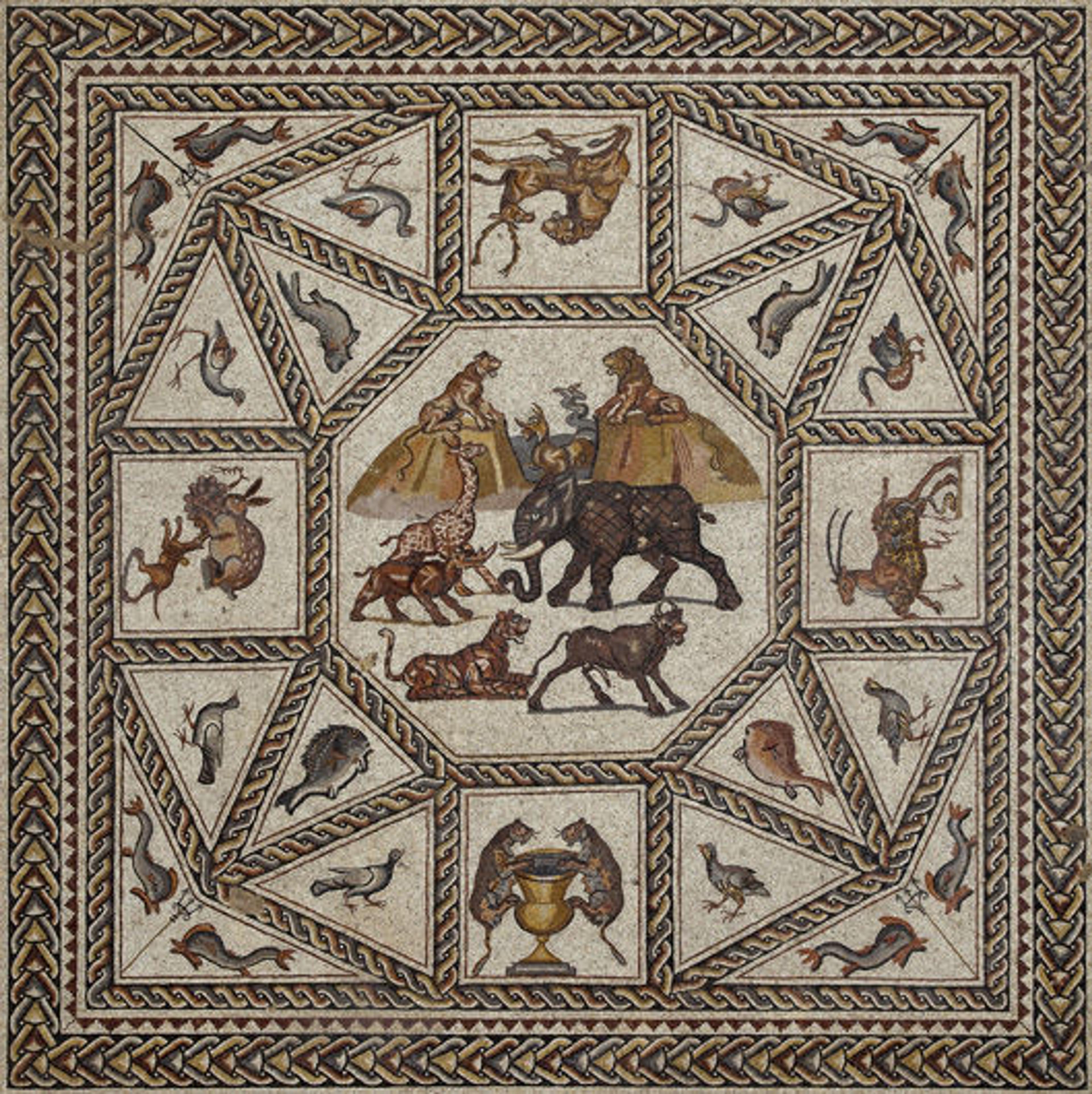
Many Roman mosaics have been found in Israel, but the discovery at Lod has attracted considerable attention because the mosaics are of exceptional quality and in an excellent state of preservation. Lent to the Metropolitan Museum for this special exhibition by the Israel Antiquities Authority are the three most impressive and well-preserved mosaics. The main panel, measuring thirteen feet square and set in the center of one of the floors, is divided into a series of smaller squares and triangles by an interlocking cable pattern, forming an outer polygon of twelve sides and sixteen square and triangular segments in which various birds, fish, and animals are depicted. These surround a larger octagonal space populated by ferocious wild animals—a lion and lioness, an elephant, a giraffe, a rhinoceros, a tiger, and a wild bull—with a mountainous landscape flanking a ketos, or mythical sea creature. Adjoining the central panel on its northern and southern sides are two rectangular panels, forming a central decorated "carpet" measuring more than twenty-three and a half feet by thirteen feet. This was surrounded by a plain floor in white stone tesserae decorated with occasional black-checkered stars within a black frame.

The northern rectangular panel is decorated with interlocking cable patterns and animal scenes that clearly echo the design and subject matter of the main panel, but the other is completely filled with a lively marine scene. Similar fish and dolphins can be found on the other two panels, but here they are shown swimming in a transparent sea, accompanied by shells and two large merchant ships facing in opposite directions, one shown with billowing sails, the other with its mast and sails lowered.
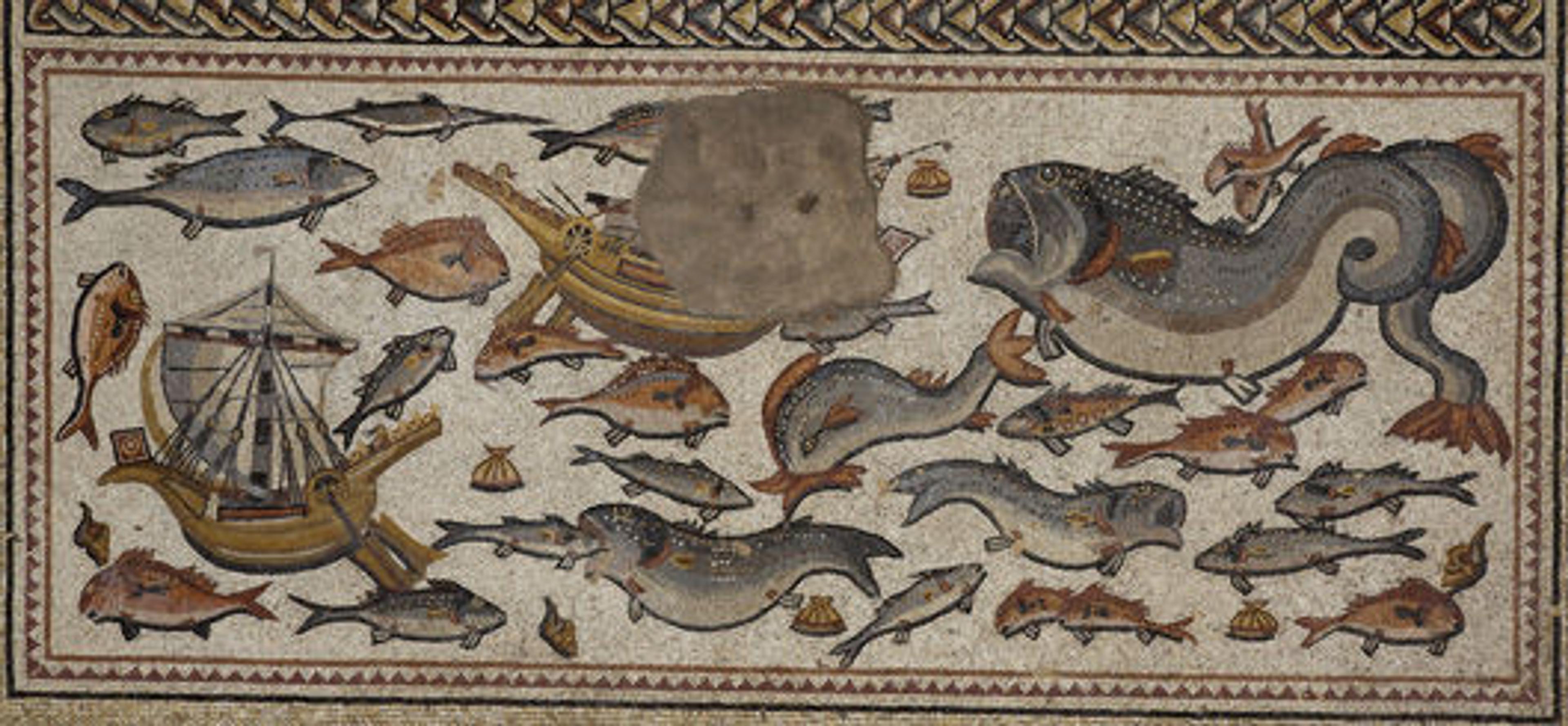
The juxtaposition of animal hunting scenes and a marine scene, combined with the lack of human figures on any of the floors, makes the Lod Mosaic very unusual. Because the mosaic's imagery has no overt religious content, it cannot be determined whether the owner was a pagan, a Jew, or even a Christian. It is certain, however, that he was a wealthy local resident who wished to have his home decorated in the finest Roman style.
Discussion of the Lod Mosaic
The depiction on the Lod Mosaic of solitary or paired groups of creatures, such as a large feline hunting a grazing animal, forms part of the common stock of genre subjects. Nevertheless, the composition reveals essential differences from other known mosaics, implying that the choice of subjects was deliberate and specific. For example, the central panel with the assortment of African and other animals defies immediate interpretation.

The foreground echoes scenes of the amphitheater where exotic animals were presented in the arena as part of public games put on either by the emperor or by a local patron of high standing. Certainly the depiction of an elephant, giraffe, and rhinoceros would have been very striking in a place such as the Roman colony of Lydda on the coastal plains of ancient Palestine, where such animals would have been unfamiliar. The addition in the background of two rocky outcrops, interpreted as the mountains of Ethiopia, implies a natural setting for the animals. However, they flank an expanse of water in which a ketos is depicted. This may represent Oceanus, the ocean that was believed to encircle the ancient world (see Collections for an image of a personification of Oceanus) and, if so, would reinforce the idea of distant lands and creatures. It is possible that such a subject was of particular significance for the patron who commissioned the Lod Mosaic.
Animals such as the giraffe and rhinoceros are rarely depicted in ancient art, which makes their appearance in the octagonal medallion of the Lod Mosaic's central panel all the more remarkable. The head of a giraffe is shown, for example, on an elaborate Roman marble sarcophagus, dated ca. A.D. 190, in the Walters Art Museum, Baltimore (see image). The giraffe appears in a scene depicting the triumphal procession of Dionysus through India, together with lions, elephants, and panthers, the last of which pull the chariot in which the god rides. Another giraffe appears on a fragmentary late Roman or early Byzantine mosaic dated to the fifth century A.D. in the Art Institute of Chicago (see image). According to literary sources, the first giraffe to be seen in Rome was used for Julius Caesar's triumphal ludi, or public games, in 46 B.C. (See "Roman Games: Playing with Animals" on the Heilbrunn Timeline of Art History.)
Also dating to the first century B.C. is the earliest known representation of a rhinoceros. It appears rather inappropriately on an island in the famous Nile Mosaic from Praeneste (see image). The one-horned Indian rhinoceros was first encountered by Greeks during the campaigns of Alexander the Great, but the animal depicted on the mosaics at both Praeneste and Lod clearly has two horns and must therefore be identified with either the black or the white rhinoceros from sub-Saharan Africa. Remarkably, specimens of this large, ferocious, and very powerful beast were seemingly obtained by the Romans for shows in the amphitheater. That this was a highly unusual event is underlined by the fact that the rhinoceros features on the obverse of bronze coins minted at Rome during the reign of the emperor Domitian (A.D. 81–96). (See an example on the American Numismatic Society website.)
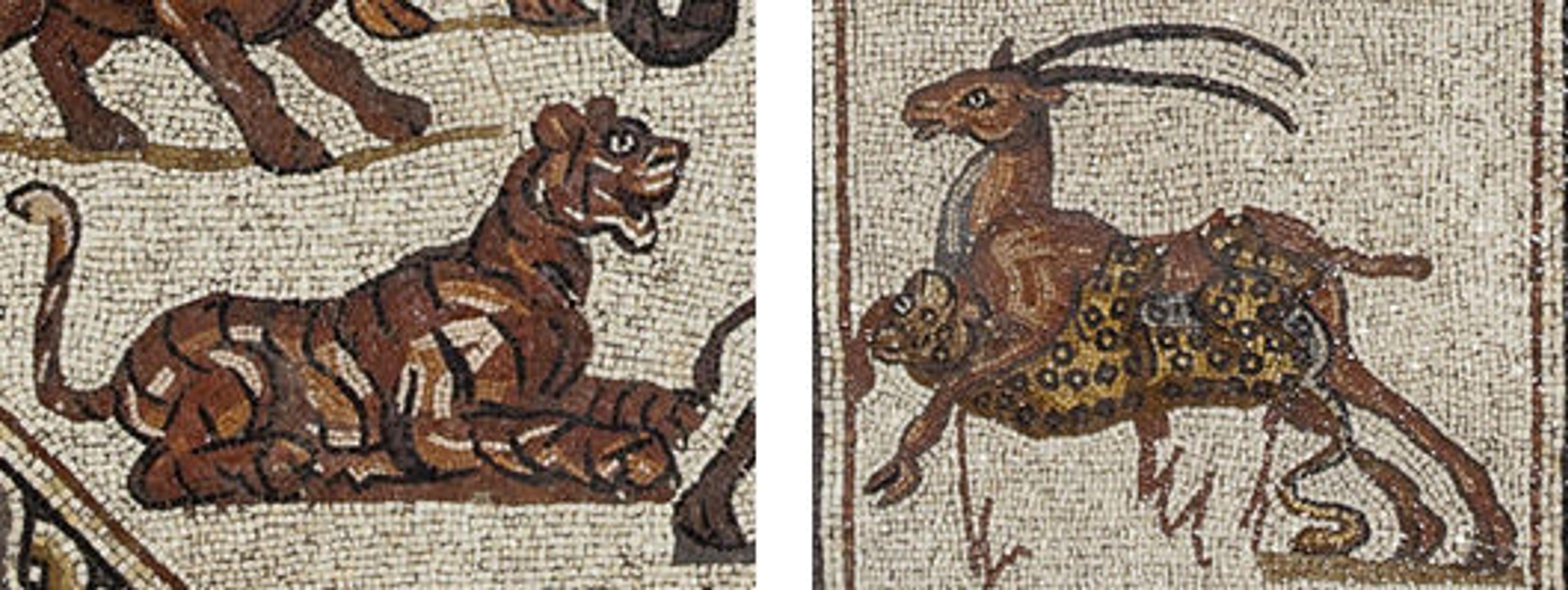
Apart from the mythical ketos, the other creatures shown on the Lod Mosaic are not so bizarre. As well as lions, three other large cats are depicted—there is a tiger in the central medallion and a leopard appears in the square to its right, attempting to pull down a long-horned gazelle. Two more tigers and leopards are seen attacking other animals in the rectangular panel at the northern end of the floor. These are in keeping with the naturalistic depictions of the various birds, fish, and other animals that are found on the Lod Mosaic, but in the square on the main axis of the central panel we find two female panthers holding on to the sides of a large metal krater (mixing bowl). (See Collections for an image of a Roman statuette of a panther.)
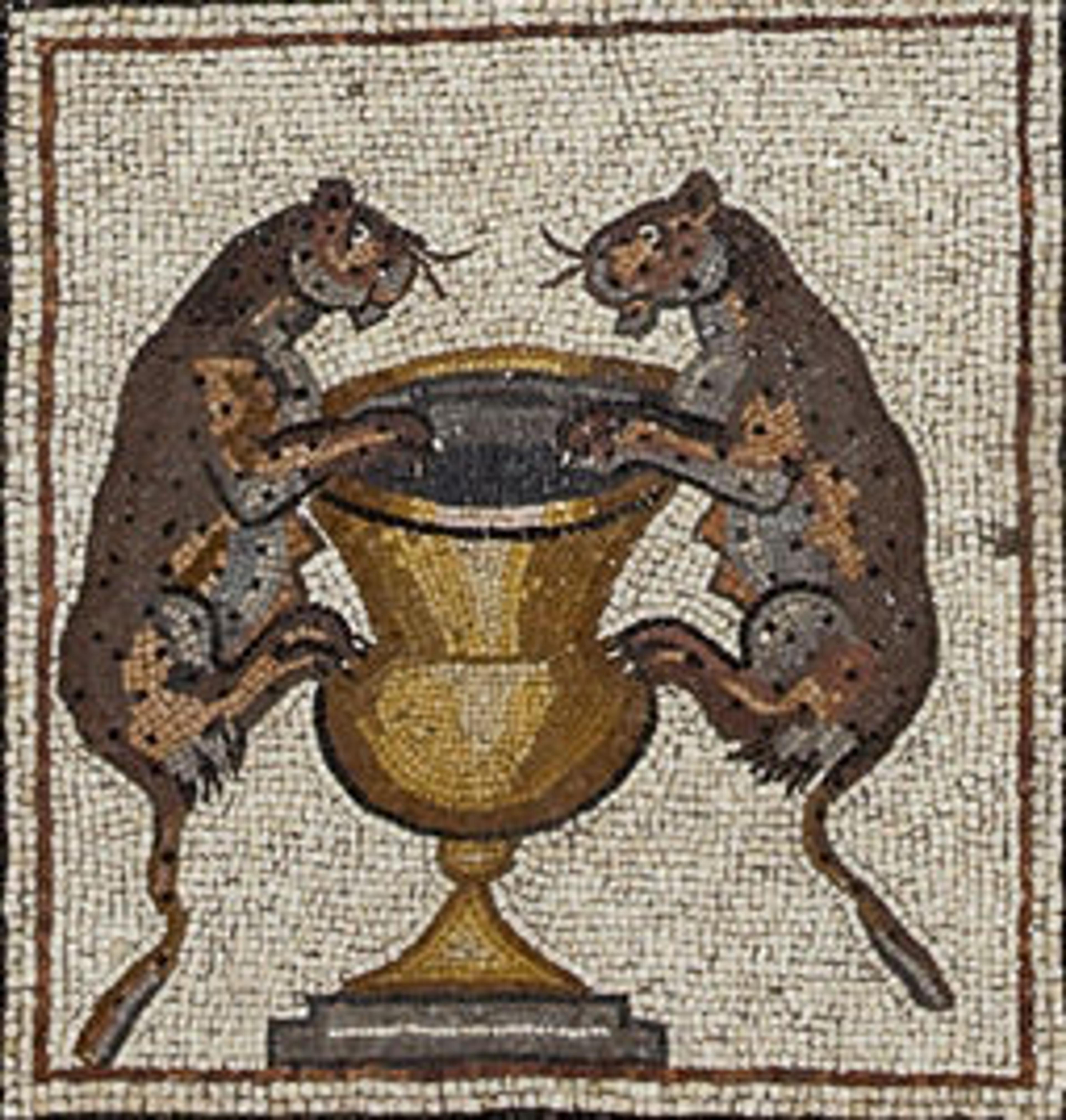
As already noted, the panther was particularly associated with the god Dionysus (see Triumph of Dionysos and the Seasons Sarcophagus), and so the scene here, as well as recalling actual examples of such vases with zoomorphic handles, may have been deliberately chosen to symbolize prosperity and well-being. The idea of wealth and generous abundance is repeated in the depiction of other large, golden vases on other sections of the mosaic.
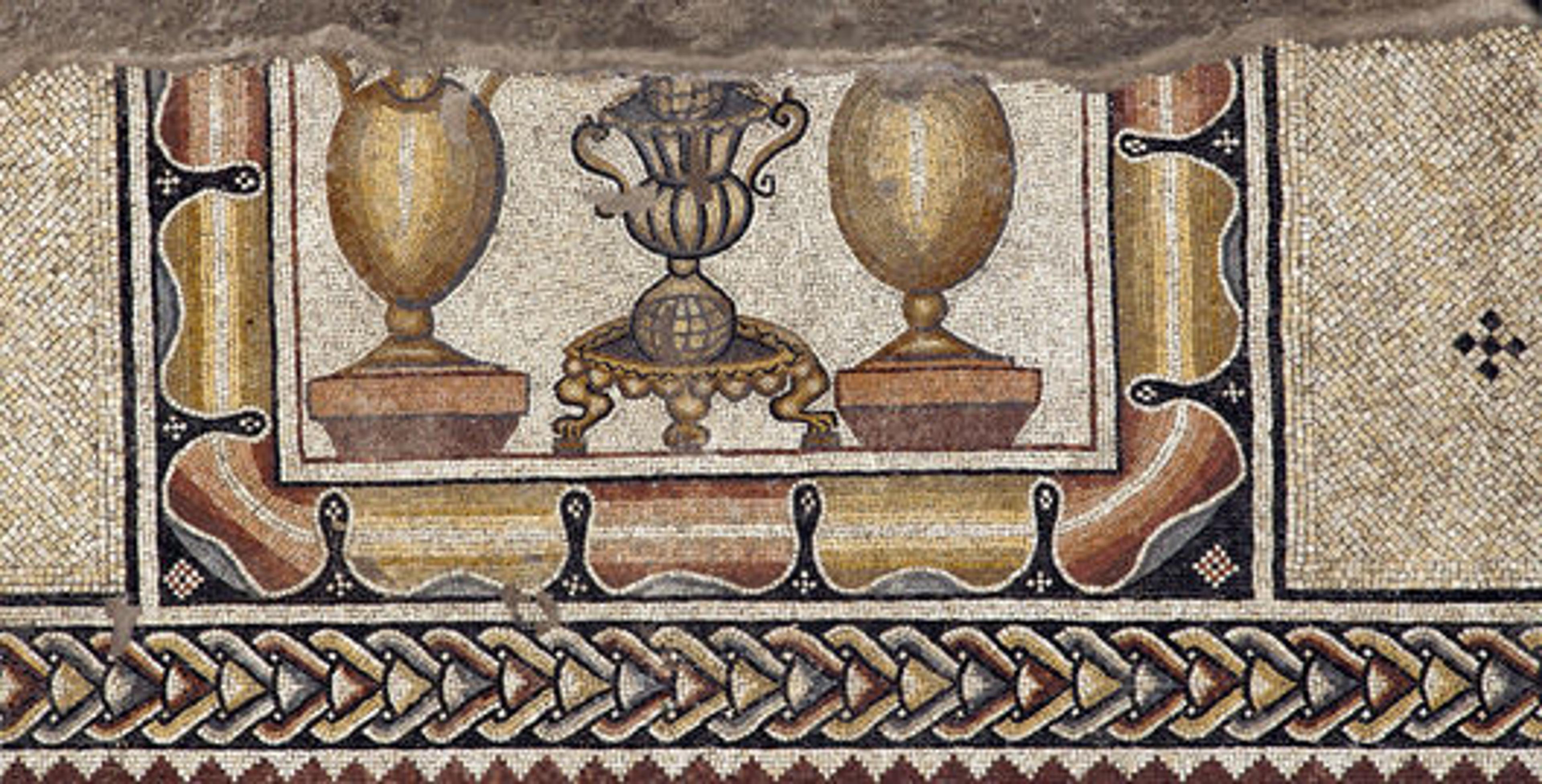
Finally, on the central medallion is a large, horned bull, identified by some as a water buffalo. (See Collections for an image of a Roman statuette of a bull.) This animal may seem to be an odd choice, given its companions, but it may in fact represent an auroch, a now-extinct species of long-horned wild cattle (Bos primigenius) that formerly roamed Europe, southwestern Asia, and North Africa.
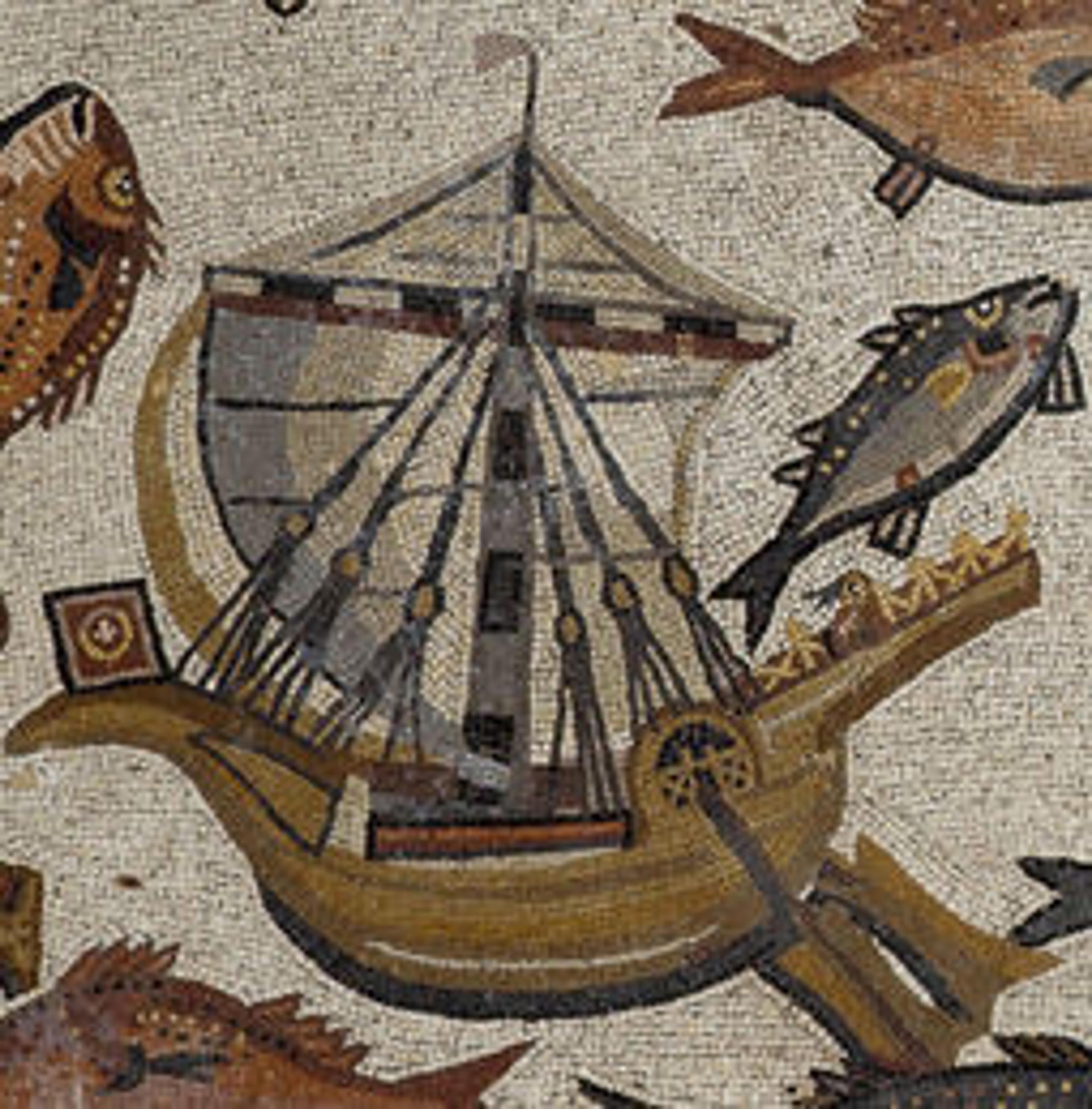
The ships in the marine scene on the southern end panel have already attracted much scholarly interest. Little, however, has been said about the creatures that populate the sea around the ships. Although the representations are stylized, the fish and marine creatures would have been much more familiar to people who lived around the shores of the Mediterranean than some of the more exotic land animals that are depicted on the Lod Mosaic. As well as the easily recognizable dolphin in the center of the panel, several different types of fish are represented, many of which presumably formed part of the regular diet at least of those who lived close enough to the sea to get fresh fish. (See Collections for an image of a Roman flask shaped like a fish.) The mosaic also depicts several marine mollusks that may be identified as murex and bivalve shells, remains of which are frequently found on ancient sites.

Various species of edible fish may be identified—bream, mullet, sea bass, and snapper—but one long, thin fish (at top left) could be seen as a barracuda and the two larger fish (one about to swallow a smaller fish) near the bottom of the panel are possibly bluefish or amberjacks.
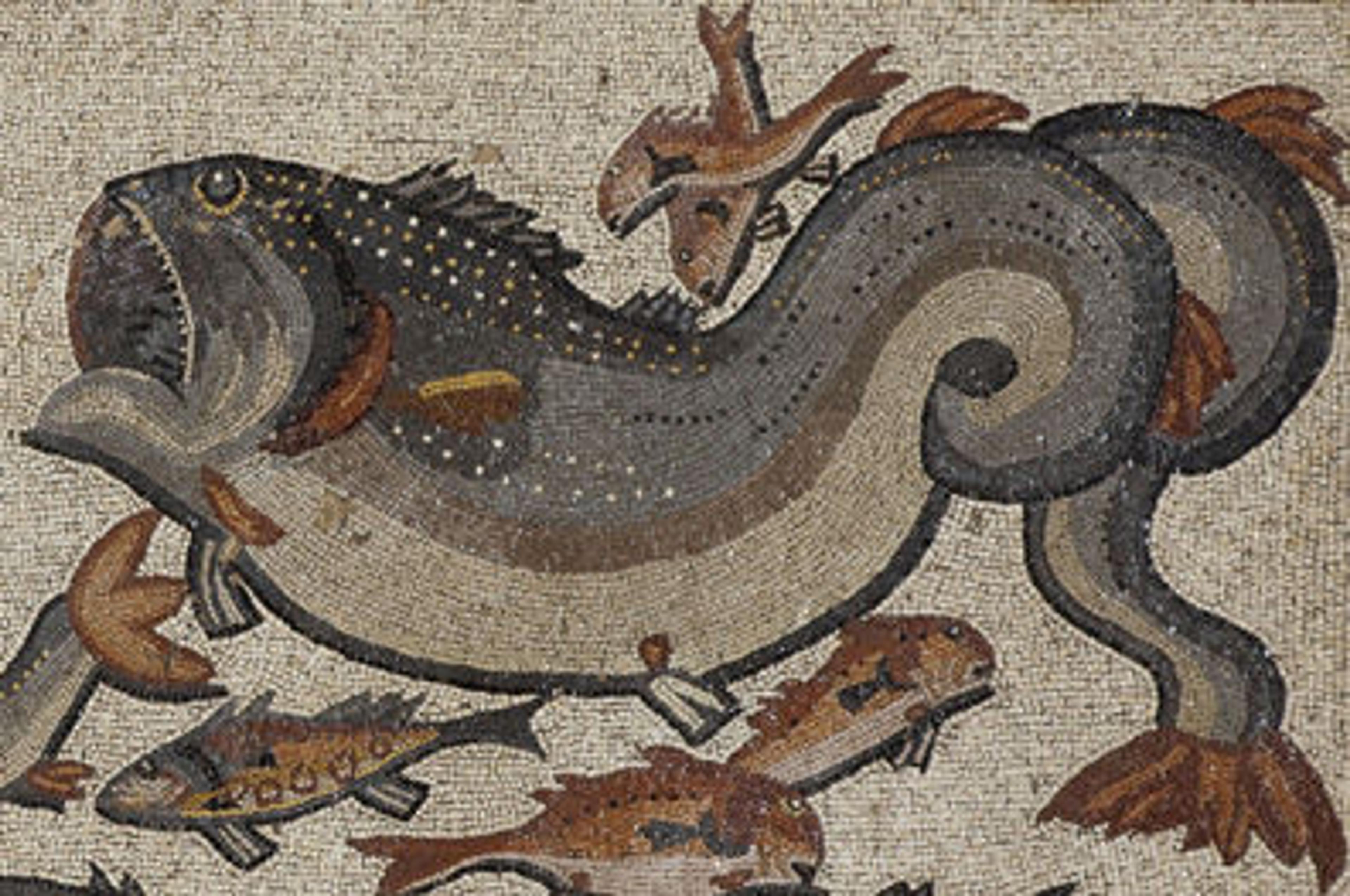
Dominating the right upper part of the mosaic is a very large fish with a long, spiral tail. In all likelihood it represents a whale, which is about to swallow the damaged merchant ship in the center of the panel. The whale has the same curly tail as the ketos on the octagonal medallion on the main panel. The two creatures were often confused and conflated in ancient literature and artistic representations.
The Laying, Lifting, and Conservation of the Lod Mosaic
The initial discovery of the mosaic in 1996 and its lifting and conservation in 2009 are documented in a four-minute video produced by the Metropolitan Museum from footage provided by the Israel Antiquities Authority. The work in 2009 produced some dramatic results that shed light on the way the mosaic was laid some seventeen hundred years ago.
Careful study of the various sections of the Lod Mosaic during the conservation work has revealed that there were two, possibly three, phases of construction. The floor containing the panels on view in the exhibition at the Metropolitan Museum is regarded as the work of a master craftsman, who was highly skilled and fully proficient in planning and laying out an intricate mosaic. The floor in the adjacent room to the south comprises two separate panels, one decorated solely with birds perched above twigs or floral sprays, the other with a highly elaborate cable pattern that includes small images of various birds, fish, and other animals, as well as mythical creatures such as a fish-tailed bull and a hippocamp. Some of the brightly colored details of these scenes are achieved by using blue glass tesserae. The combination of these two panels is not as pleasing and harmonious as in the case of the three panels in the northern room. In addition, their execution is not as precise and careful, so it has been argued that these were laid by a second craftsman whose skills were of slightly inferior quality than those of the craftsman who worked on the panels included in the display at the Metropolitan.

Between the two floors there is a long, narrow panel that is seen as marking a threshold. It contains at its center a large krater flanked by peacocks, while other birds either perch on or peck (or both) the fruit off the vine tendrils that issue from the vase. Here again many of the details are highlighted by the use of not only bright blue glass tesserae but also other vivid colors—green, deep red, and yellow—and the krater is further decorated with bands of gold glass tesserae. It is clear from the arrangement of the plain, white stone tesserae surrounding this panel that it was a later addition to the floor, probably executed by a third craftsman, although it cannot be ascertained when the changes were made.

Other valuable information was gained during the lifting of the Lod Mosaic. In some areas, incised lines were found in the mortar bedding that were used as guidelines for the frame of black tesserae surrounding the panels. Additionally, underpainting was found on the nucleus layer of the mortar bed before the tesserae were laid out for the fish panel. This indicates that all the figures were carefully and precisely placed in this complicated composition, following a design that had been previously made. During the laying of the mosaic some of the workmen left impressions of their feet and hands in the wet mortar; both bare footprints and sandaled feet have been found. It is highly unusual to have such details of the actual construction process preserved, and it is to the credit of the Israeli team that lifted the mosaics that they not only documented them in situ but also lifted them so that they, too, can eventually be exhibited alongside the mosaic when it returns to Lod.
Mosaics in the Roman World
Most mosaics were laid on the floor. They form one of the most well-preserved and widespread types of Roman art, found throughout the Roman Empire from Britain and Spain in the west to Jordan and northern Mesopotamia in the east. They were used in public buildings such as Roman baths and marketplaces and, in late antiquity, in places of worship such as synagogues and churches. The majority of mosaics, however, decorated private buildings, both large city houses and villas in the countryside or by the sea. Mosaics were a costly and time-consuming addition to a property, although they would thereafter require little maintenance and could be expected to last a lifetime. Because of the heavy initial investment, considerable care and attention was paid to creating designs that were attractive and appropriate, both to the owner and to the setting.
Mythological scenes were popular, presumably because they were timeless and familiar classics, though they may also have been deliberately chosen to signify the owner's learning, taste, and sophistication. Scenes of what may be called daily life—activities such as hunting, fishing, and circus races and games involving gladiators, other fighters, or animals—also had great appeal. Some of these are subject specific, depicting, for example, the lord of the manor and his retinue or contestants in the arena, complete with their names. Perhaps the most famous example is the mosaic in the entrance to the House of the Tragic Poet at Pompeii in which a ferocious-looking guard dog is depicted together with the warning cave canem (beware of the dog).
Despite the diversity in their manner of execution, design, geographical setting, and dating, Roman mosaics display a number of shared or common characteristics. It is likely that some elements of the Lod Mosaic drew on standard pattern books, perhaps even ones compiled elsewhere in the Roman Empire. Parallels for certain features of the Lod Mosaic can be found on other examples from the same region, but North African mosaics have also been regarded as the source for some of its elements, notably the marine scene. The inclusion of specifically African animals—the elephant, giraffe, and rhinoceros—also points to some connection with that part of the world. Similar patterns and scenes can be seen on mosaics throughout the Roman world. For example, counterpoised dolphins are common on Hellenistic mosaics from Delos, marine scenes figure on mosaics recovered from Pompeii, and panels depicting animals and birds within geometric frames appear on floors at Cologne in Roman Germany.
Mosaics as an Art Form
The perspective from which scenes on floor mosaics were viewed differed markedly from other forms of two-dimensional art, such as paintings and reliefs. This allowed mosaics to be designed so that they could provide multiple viewpoints. People could walk around and, indeed, over the mosaic to see scenes orientated in different directions. As a result, figures could be depicted as floating against a minimal background, which was ideal for heavenly divinities or sea creatures, as in the case of the marine panel of the Lod Mosaic.
Another feature of mosaics that lends to their appeal is that recognizable shapes and scenes are created not out of painted or carved lines but by the painstaking arrangement of small cubes or tesserae made of different colored stone, terracotta, or glass. There is therefore an overall trompe l'oeil (trick of the eye) effect in creating naturalistic patterns from unpromising materials in a most unexpected way. The most impressive examples are in the so-called vermiculatum (wormlike) technique, in which very small cubes measuring no more than 5/32 inch (4 millimeters) on each side were used. Naturally, such mosaics were very costly and so were relatively small in size. They were usually made as separate panels known as emblemata and set in floors of larger-sized tesserae. Entire mosaics could also be designed to provide specific trompe l'oeil effects, the most famous of which is the asarotos oikos (unswept room) mosaic, originally attributed to Sosos of Pergamon (see image). Discarded remnants of a meal are realistically depicted on a plain floor of white tesserae, thereby playing tricks on the viewer and encouraging him or her to appreciate the three-dimensionality of a two-dimensional floor surface.
Regular-sized cubes, however, did not lend themselves to representing complex figural scenes, especially when the distance from which they could be viewed was limited. On the other hand, mosaics placed on a floor were ideal for making repetitive geometric patterns. Early pebble mosaics were often based on a simple checkerboard pattern of alternating black and white squares, but in Roman times there developed an extensive repertory of non-figural designs incorporating geometric and floral patterns. Some of these are very ornate and intricate, and they often served as borders for major figural scenes, rather like the way in which famous European oil paintings have ornate frames. But the most successful and striking designs are those that cover the entire floor with purely abstract patterns. This is an aspect of mosaics that is quite exceptional in ancient art, which was otherwise very much based on realism and the human form. The appeal undoubtedly was that a mosaic comprising an interlocking grid of lozenges in contrasting colors gave the impression of three-dimensional space. (See the Heilbrunn Timeline of Art History for another example in the Museum's permanent collection.)
Mosaics are highly characteristic of the Roman world and provide valuable information about the tastes and preoccupations of at least the well-to-do who commissioned their production. They may also offer insights into other ancient arts that were less permanent, especially easel paintings, textiles, and, most of all, carpets. Their legacy was to the religious art of the Byzantine world and its successors. Whether one admires their artistic or practical qualities, mosaics retain their appeal and are still used today to decorate many public places, including subway stations in New York City (see image).
Related Exhibition
The Roman Mosaic from Lod, Israel (September 28, 2010–April 3, 2011)
Related Podcast Episode
Christopher Lightfoot brings to life the colorful animals of air, land, and sea that populate a large floor mosaic from the ancient Roman Empire that was discovered accidentally in 1996 during road construction in Israel. Download the audio file.
<p>Please enable flash to view this media. <a href="http://get.adobe.com/flashplayer/">Download the flash player.</a></p>
Transcript available in Met Media
Related Link
Lod Mosaic website
Publications
M. Avissar, "Lod–A Mosaic Floor," Excavations and Surveys in Israel 17 (1998), pp. 169–172.
A. Ovadiah and S. Mucznik, "Classical Heritage and Anti-Classical Trends in the Mosaic Pavement of Lydda (Lod)," Assaph, Studies in Art History 3 (1998), pp. 1–16.
R. Talgam and Z. Weiss, "The Mosaics of the House of Dionysos at Sepphoris," Qedem 44 (Jerusalem 2004), pp. 12–15, figs. 12–14.
E. Haddad and M. Avissar, "A Suggested Reconstruction of one of the Merchant Ships on the Mosaic Floor in Lod (Lydda) Israel," The International Journal of Nautical Archaeology 32.1 (2003), pp. 73–77.
Z. Friedman, "The Ships depicted in the Lod Mosaic Reconsidered," The International Journal of Nautical Archaeology 33.1 (2004), pp. 164–168.
Further Reading
K.M.D. Dunbabin, Mosaics of the Greek and Roman World, Cambridge: Cambridge University Press, 1999.
Toynbee, J.M.C. Animals in Roman Life and Art. Baltimore and London: The John Hopkins University Press, 1973.
Text Acknowledgements
With many thanks to Jacques Neguer (Art Conservation Department, Israel Antiquities Authority), Drs. Lynne Parenti and Victor Springer (National Museum of Natural History, Smithsonian Institution), Pamela Barr (Editorial, The Metropolitan Museum of Art), and especially Jacob Coley (Greek and Roman Art, The Metropolitan Museum of Art).
Christopher Lightfoot
Christopher S. Lightfoot is a curator in the Department of Greek and Roman Art.